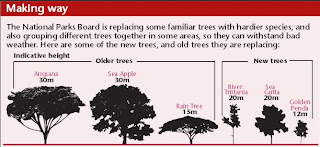Kenneth Chia Today Online 19 May 13;
Besides the chopping down of trees every now and then for various reasons, I am concerned with the way trees are trimmed periodically in Singapore. I use the word “trimmed”, although not only are small branches lopped off, but major ones are, too.
I have observed this overkill over the decades. Trees that were violently trimmed became stunted in growth after that, growing at a fraction of their former rate. Apart from that, residents are deprived of much of the shade provided by the trees’ former luxuriant foliage.
Trees are living things, which should be treated with respect and tenderness, especially when they are beneficial to us. If we treat nature properly, we would be blessed by it in ways we may not know.
Our government has done wonderfully to make Singapore a green city by planting and maintaining trees and flowering plants across the island. Given that trees are under the State’s jurisdiction, it seems right that the authorities can look after them in any way they see fit.
However, I request a review of the manner in which they are being treated, like inanimate possessions to own and discard with abandon. Humans do not own nature, be it a tree or flowering plant. At best, we are gardeners, not possessors.
Pruning enhances stability of trees during rainstorms
Oh Cheow Sheng, Director, Streetscape, National Parks Board
Today Online 28 May 13;
We thank Mr Kenneth Chia for his feedback in the letter, “We are gardeners, not possessors” (May 19, online).
Our tree care programmes are put in place to reduce the risks of storm damage. Pruning is required to reduce the weight of tree crowns to enhance tree stability during rainstorms and to reduce the risk of branch breakage. We are mindful not to over-prune our trees in the process.
As for the photograph Mr Chia had sent in, we wish to clarify that the tree, which was located at Bedok Reservoir Road, was not being pruned. It was being removed to enable the repair of an underground leaking water pipe.
We seek the public’s continued support, as we are fully committed to caring for our trees while upholding our responsibility of minimising public safety risks or damage from trees.
For further feedback, Mr Chia and members of the public are welcome to contact us at 1800 471-7300 or email us at NParks_Public_Affairs@NParks.gov.sg
Read more!





